The ASUS Zenbook UX305 Review
by Brett Howse on March 25, 2015 8:00 AM ESTDisplay
The UX305 comes with two display options. The base model is a 13.3 inch 1920x1080 IPS display, and no touch available. The display has a matte finish to it, which helps with glare. ASUS will also be offering a 3200x1800 Plane-to-Line Switching (PLS) model with a matte finish, and that model should be available in April or so. Optionally, both models can be equipped with touch.
The model that we received is the 1920x1080 version, and the display is from AU Optronics and is model AUO212D. At 166 pixels per inch, it is a good resolution for this size of display. It is a full RGB stripe, which is pretty typical for this resolution and size panel.
The anti-glare coating causes the sub-pixel distortion seen on this image. The AU display is a 6-bit model, but that is unsurprising given the low cost of this device. As an IPS display, it has great viewing angles and is a big step up over the TN panels that you may still find at this level of cost.
To test the display accuracy and its ability to reproduce color, we use SpectralCal’s CalMAN 5 software suite, with an X-Rite i1Display Pro colorimeter for brightness and contrast readings, and the X-Rite i1Pro spectrophotometer for color accuracy.
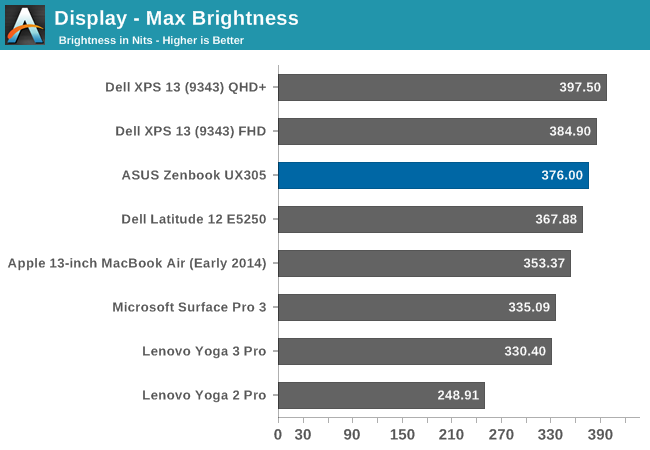
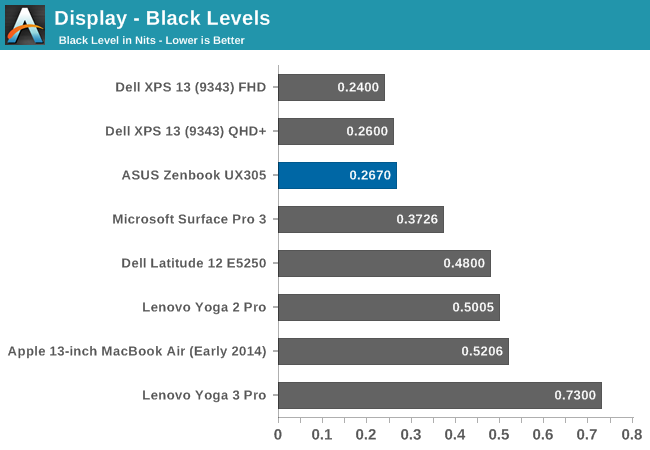
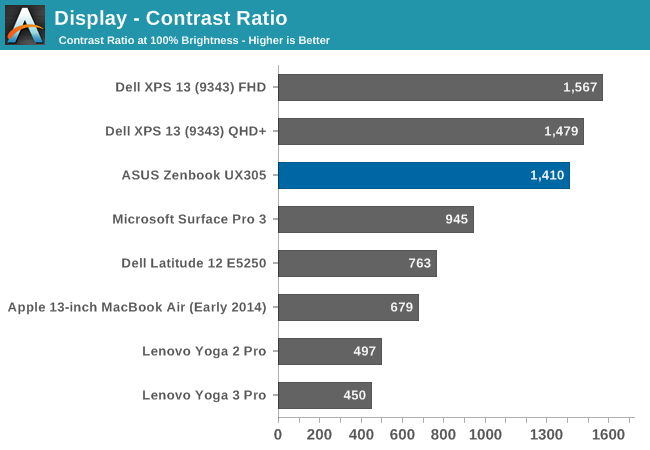
The maximum brightness for the UX305 is an impressive 376 nits. This combined with the anti-glare coating should make this a great laptop for any sort of bright room, or even outside. Even better, the panel has excellent black levels. ASUS rates the display for a contrast ratio of 500:1, but the model we received blew past that for a 1410:1 ratio which is fantastic.
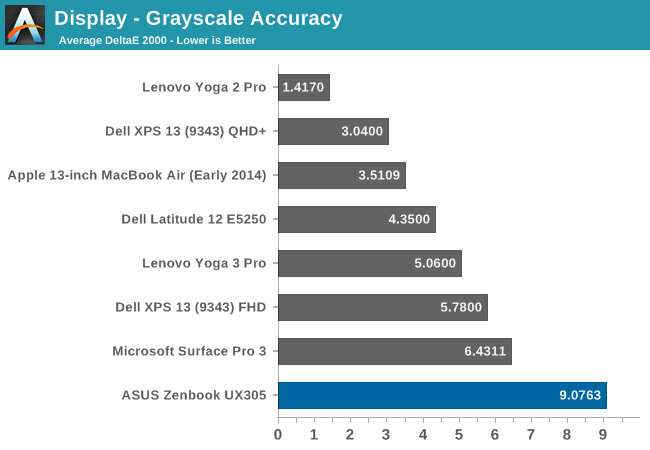
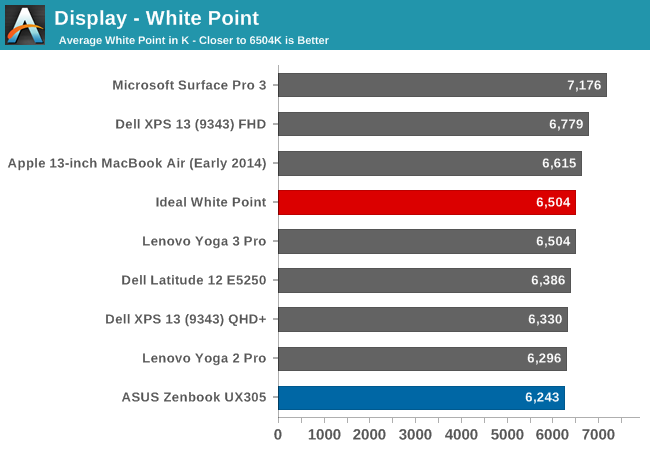
Unfortunately the great brightness and contrast is about where this display ends. The grayscale average is actually flattering the ASUS with a score of just over 9, because the error rate is between 12 and 13 from 70% brightness on. These are huge errors, since anything over 5 is a poor result, and really we are aiming for scores under three. The white point is off, and there is a huge green shift in the display by default.
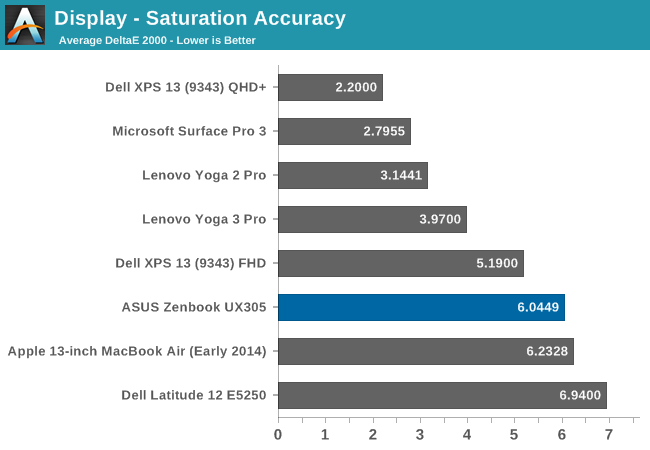
The saturation sweeps are not quite as bad as the grayscale, with the UX305 coming in just over 6. It is oversaturated on blue, undersaturated on red, and there is a green shift which pulls the yellows and teals off of their axis.
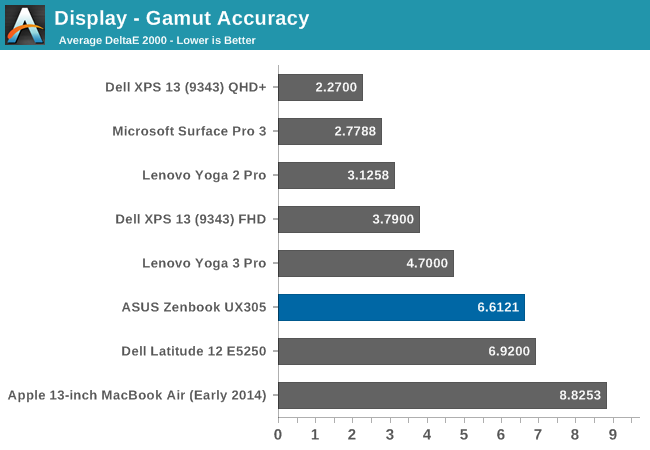
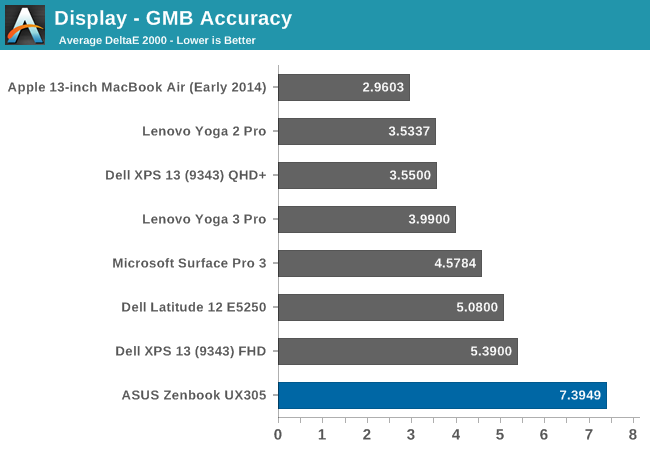
The GMB test is a more comprehensive test, and it scores very poorly again with a score over seven. The worst offenders were of course the white levels, which are very off, and the flesh tones on this display all had errors way over many of the other colors.
This is a very poor result and throws us back several years in terms of calibration. As far as out of the box performance goes the display can hit the entire sRGB colorspace, and as an IPS display it has great viewing angles, but otherwise there is nothing good to be said about this display as far as out of the box color accuracy goes.
To see if the display can be improved on with aftermarket calibration, I have run the display through our calibration software to try to fix some of the errors we encountered. Generally icc profiles will only really have a major effect on the grayscale, but that is the worst part of this display so hopefully we will be able to fix some of these issues.
Once calibrated, the display is almost completely different. There is still a large error on 100% white, but the overall grayscale drops to 0.9582, with a bit too much green but it is barely noticeable on most levels. The gamut drops to just 3.1256, saturation plummets to 1.9571, and the GMB test comes in at 2.3099.
If ASUS would take the time to include an icc profile for this display from the factory, it would be a lot better. It is amazing to me that ASUS would ship this display with it so far out of calibration, especially when calibrated it is almost perfect. Yes, the $699 price point is a factor, but the hard work was already done in getting a display that can produce these numbers. The easy part is taking the time to make it do that.


















164 Comments
View All Comments
FwFred - Thursday, March 26, 2015 - link
Microsoft store had it for $699. Amazon let's other resellers sell at any price they want, Amazon didn't have it in stick themselves when I checked.dionisk - Tuesday, April 7, 2015 - link
Just bought it 3 days ago from amazon for 699. You just need to keep looking. Amazons prices fluctuate based on their supply.fabrica64 - Friday, March 27, 2015 - link
Too bad it is a 16/9 laptop. Stop 16/9 displays! Why can't people put a 16/10 display... a little bit more of squareness makes a lot of differenceArtShapiro - Friday, March 27, 2015 - link
You're obviously correct, but in (somewhat) fairness, that 1080 pixel vertical resolution is 30 more pixels than an SVGA+ device provides. I like my 1600x1200 Thinkpads, but my 1400x1050 Thinkpads are certainly reasonable.I've never paid much attention to Ultrabooks, but this strikes me as a very intriguing machine, especially for travel. My only Asus device is their now no-longer-produced Mini-TS Windows Home Server box, and it's done fine for quite a few years. What's bothering me is that the more-expensive "Signature" edition is touted as having no bloatware and, curiously, some sort of illy-defined optimization for Windows. That implies that the non-signature edition has some non-optimized Windows settings, whatever that might mean.
Supercell99 - Sunday, March 29, 2015 - link
As someone who recently purchased a ASUS UX303LA Ultrabook, only to find that a design flaw /weakness has rendered it useless, due to the display hinge breaking. I would advise anyone considering an ASUS Ultrabook to look into the hinge/construction on the newer models to see if the have attempted to correct this flaw, in how the thin plastic that attaches the display to the base.Touch screens receive a lot more handling on and by the display in everyday use than non-touch screens and require at least as strong or stronger attachment to the hinge than regular laptops. ASUS neglected to do so with the UX303 series and is resulting in a high failure rate of display/hinges. (see amazon review for example).
Anandtech, while likely beyond the scope of this type of review, please look deeper into the durability and construction of these ultra-portables in the future, as light weight construction techniques , can begin to translate into premature physical/mechanical failures.
eanazag - Monday, March 30, 2015 - link
What is interesting to note is that the Arm tablets' performance results can actually be posted alongside these laptops and not result in flat out jokes. At least in the web results. Convergence in performance is beginning to be real.Allan_Hundeboll - Wednesday, April 1, 2015 - link
I bought the version with 128Gb SSD yesterday. My first impression was disappointment because the 1080p ips screen has alot of light bleed in the bottom. The way this zenbook digs into soft tables is also irritating. But I love everything else about it.SNV - Wednesday, April 1, 2015 - link
Since laptops now are being stripped of any moving parts they should be silent, or so you'd think, but now that there is no humming from the cooling fan or buzzing from the harddrive, and suddenly the sounds from badly designed electronics can no longer hide behind mechanical noise. I propose a new test for electronics like laptops and tablets, the coil wine test. Do a search on "Dell XPS coil whine" (be it XPS 13 or 15 or Precision M3800) and you'll see what all the fuzz or should I say whining is about.A laptop can be fast, light, good looking, have high quality haptics, a battery that will last for days, and no moving parts hence promising no mechanically induced noise, but it can and will probably have some component on the PCB that is screaming IIIIIIIIIHIHIHIHIHIHIHIHIHIHIHIH constantly due to lack of proper EMC shielding of the circuits. The question is will this sound be loud enough to be heard by a user’s ears.
The Dell XPS 13 is winning quite a few tests in this review, but it wouldn't do well in a sound test looking for noise from the electric circuits within the dB(A) range at a distance were a users ears would be.
PhytochromeFr - Thursday, April 2, 2015 - link
Explain is insufficient. intel core's throttling is more complex than that.It's mainly ruled by power usage condition. NOT thermal condition. Intel set 2 turbo power limit for turbo control. short and long. If Processor boost to maximum clock, package power usage reach short limit. core sustains a few seconds maxmum clock until averge power usage in time window reach long limit. after that, core throttles down their clock to until their power usage reach long limit.
Allan_Hundeboll - Tuesday, April 7, 2015 - link
I tested throttling on my ux305 with occp. Idle frequency when running on battery is 800mhz. When plugged in the mains idle freq. is 2ghz.100% CPU load will make the CPU spike @ 2ghz, but quickly settle @ 1.5ghz. 100% CPU and GPU will make the CPU settle @ 700-800MHz. It doesn't get hot so I'm guessing it's because of the power usage.